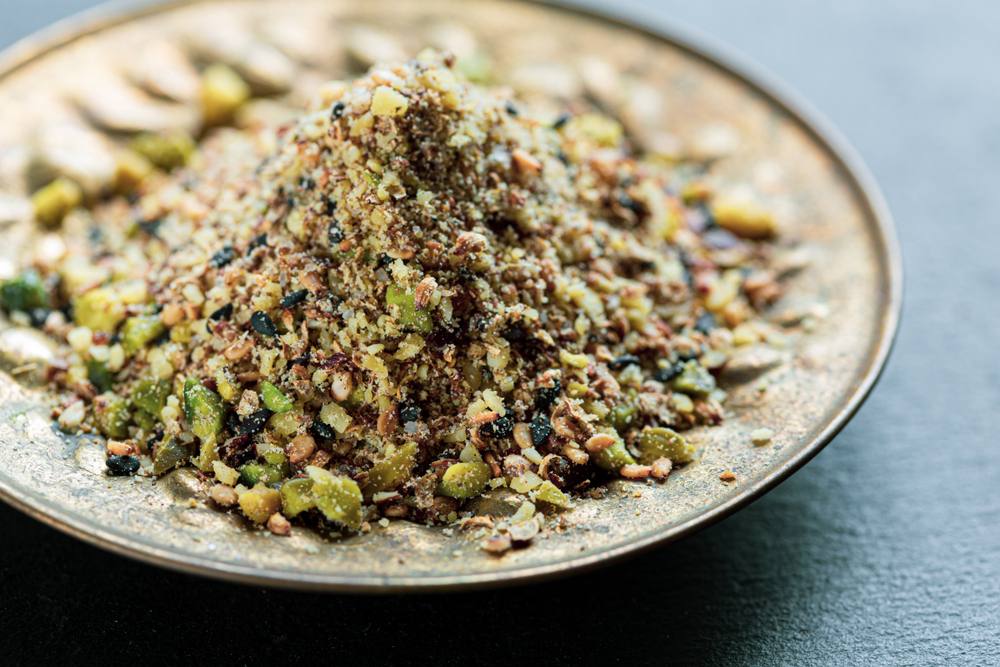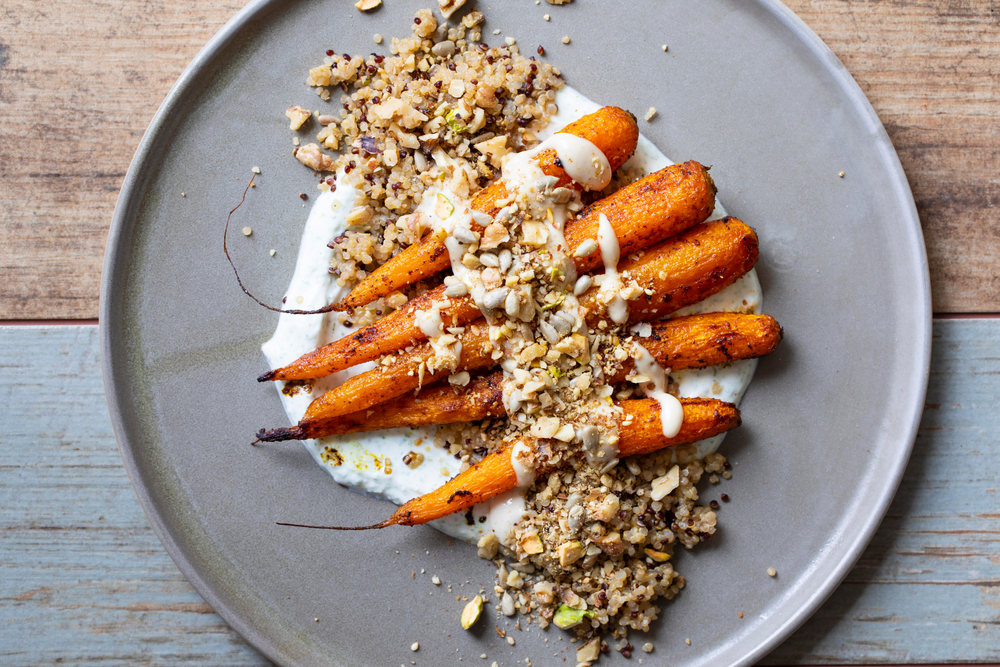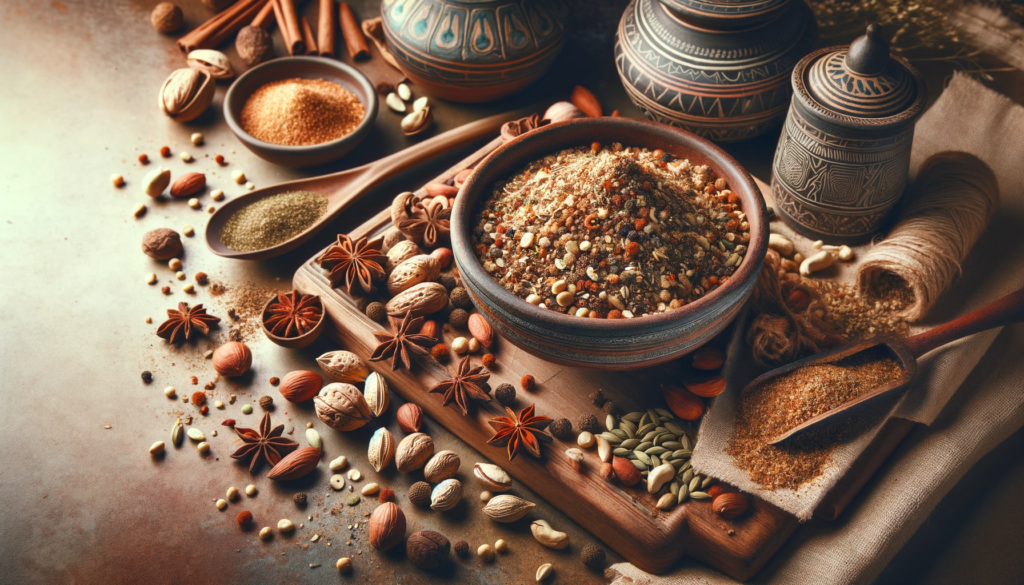Dukkah Uncovered: An Egyptian Culinary Treasure
Dukkah, a blend that has echoed through the bustling alleys and gentle wafts of Cairo’s spice markets, carries the essence of Egypt’s rich culinary traditions. Its unique mixture of nuts, seeds, and spices represents a symphony of flavors adored by both locals and gourmands globally. The cornerstone of Dukkah lies in its versatility, with each ingredient contributing to its complex, earthy profile. A careful combination of roasted nuts—such as hazelnuts or almonds—provides a nutty canvas, on which the subtleties of sesame, coriander, and cumin seeds are painted. Often ground together into a coarse concoction, Dukkah bridges the palates from the simplicity of bread dipping to the finesse of gourmet cuisine.
The Composition and Flavor Profile of Dukkah
The heart of Dukkah pulsates with a carefully-crafted assembly of flavors. Typically starting with a nutty base, hazelnuts or pistachios are favored for their rich, substantial taste, while sesame seeds layer on a toastiness that is both warm and inviting. Coriander seeds bring a citrusy, woody note that balances the robustness of cumin’s earthy pungency. Some variations include peppercorns, fennel, or dried mint, broadening its aromatic appeal. This blend, as diverse as the Egyptian landscape, can be fine-tuned to personal taste, with salt often serving as the component that unifies these dynamic flavors into a harmonious culinary composition.
Historical Roots and Cultural Significance of Dukkah in Egypt
Dukkah’s lineage is as ancient as the pyramids themselves, ingrained deeply in Egypt’s cultural and culinary lore. It began as a sustenance for the weary traveler and the working class, offering a burst of energy and flavor to an otherwise staple diet of bread. As spices were traded along the Nile, Dukkah evolved into a symbol of hospitality and community, with each family boasting a signature blend. Often paired with bread and olive oil, Dukkah has transcended generations, finding itself at the intersection of history and gastronomy, an edible heirloom of Egypt’s ancestral tables.

Dukkah in Egyptian Cuisine
Traditional Uses of Dukkah in Egyptian Cooking
Traditionally, Dukkah has graced Egyptian tables as a companion to bread and olive oil, where a simple dip translates to an explosion of texture and savor. Beyond this customary use, it serves as a staple seasoning, finding its way into marinades, offering a crust for meats and fish, or being sprinkled atop humble legumes and salads. Its adaptability is a testament to its rooted presence in the food culture of Egypt; from the lapping shores of the Mediterranean to the Nubian south, Dukkah permeates culinary traditions both as a condiment and a centerpiece.
Modern Adaptations of Dukkah in Egyptian Dishes
In the ever-evolving landscape of modern Egyptian cuisine, Dukkah continues to be reimagined. Chefs cultivate new applications, be it as an accent to avant-garde appetizers or an infusion within contemporary confections. Home cooks, meanwhile, sprinkle it on avocado toasts or blend it into smoothies, contributing a nutritious spike to their meals. The versatility of Dukkah ensures its relevance, thereby cementing its status not just as a remnant of the past but as an innovator within the flavorful journey of Egyptian gastronomy.
Crafting Dukkah in Your Kitchen
How to Make Your Own Dukkah Blend
Creating your own Dukkah invites you to dabble with the multitudes of flavor profiles that define this spice blend. Begin with selecting your favorite nuts and roasting them to coax out their aromatic oils. Next, toast sesame, coriander, and cumin seeds, paying close attention to their fragrance and the subtle hints that signal they are ready. Grinding the melange coarsely allows Dukkah to maintain its characteristic crunch. Lastly, weaving in your choice of additional spices, and a generous pinch of salt will secure your personal stamp on this time-honored Egyptian condiment.
Creative Ways to Cook with Dukkah
Embracing Dukkah in the kitchen means unlocking a realm of possibilities. Its application can range from the simplest gesture of seasoning boiled eggs to crusting succulent cuts of meat or fish. Vegetarians can rejoice in Dukkah’s ability to add depth to roasted vegetables or to transform a basic hummus into an exotic spread. For a creative twist, consider mixing Dukkah into doughs for baking, yielding breads and crackers that encapsulate its nuanced flavors from the inside out.

The Global Appeal of Dukkah
Dukkah’s Influence in International Cuisines
The global palate has warmly embraced Dukkah, recognizing its capacity to infuse global dishes with a touch of Egyptian finesse. It’s not uncommon to find it seasoning delicate European pastries, complementing the rich flavors of Australian lamb, or offering an intriguing twist to Asian stir-fries. As fusion cuisine continues its march towards innovation, Dukkah rides in tandem, lending its aromatic bouquet to dishes far and wide, which serve to underscore the spice blend’s universal appeal and adaptability.
Innovative Recipes Incorporating Dukkah
Bringing a slice of the Nile to international kitchens, Dukkah has found its way into innovative recipes that defy expectation. Imagine it gracing the outside of a chocolate truffle, providing a savory contrast to sweetness, or within the layers of a lasagna, offering an unexpected crunchy bite. Chefs sprinkle it over gourmet pizza, mix it into piquant dips or compound butters, and even swirl it into ice creams, showcasing its culinary flexibility and underlining that there are no borders when it comes to flavor exploration.
Bringing the Flavors of Egypt Home
Authentic Egyptian Recipes Featuring Dukkah
For those seeking the authenticity of Egyptian kitchens, incorporating Dukkah into traditional recipes is the key to unlocking that authenticity. A sprinkle of Dukkah over ful medames (fava bean dish) adds a textural contrast, while blending it into kofta kebabs elevates these meaty delights with a nutty undertone. Incorporate it into the filling of mahshi (stuffed vegetables), or dust it atop ta’meya (falafel) for that extra crunch, allowing each bite to be a celebration of flavors rooted in the banks of the Nile.
Fusion Dishes Inspired by Dukkah’s Unique Blend
Fusion cuisine has welcomed Dukkah with open arms, creating captivating dishes that harmonize Egyptian flavors with global influences. An interesting fusion could be a Dukkah-crusted tuna served atop a bed of greens, where the seared crust’s crunch complements the fish’s tenderness. Another could be a savory take on French toast, infused with Dukkah to craft a breakfast twist that is both familiar and entirely new. The bold home chef might even pair Dukkah with sweet components to experiment with delectable, unconventional pairings bound by creativity.

Dukkah in Egyptian Cuisine: FAQs
What is the best way to store Dukkah?
To maintain Dukkah’s freshness and flavor, the ideal storage method is to keep it in an airtight container, stowed away from light and heat. A pantry or cupboard, away from stovetops or ovens, provides the perfect environment. Under such conditions, Dukkah’s integrity of taste is preserved, ensuring that each use adds the desired texture and flavor to your dishes.
Can Dukkah be made nut-free?
Indeed, Dukkah can be crafted without nuts to cater to allergies or preferences. Substituting nuts with seeds, such as pepitas (pumpkin seeds) or sunflower seeds, still contributes the essential crunch and flavor. This versatility allows Dukkah to remain an inclusive and adaptable component of culinary creations, providing a way for everyone to enjoy its rich taste.
Is Dukkah gluten-free?
Naturally, the classic Dukkah blend is devoid of gluten as it typically consists of nuts, seeds, and spices. However, when purchasing commercial Dukkah, or for those with severe gluten intolerances, it is vital to ensure that the product has not been contaminated during processing. Always check the label or, when in doubt, consider making Dukkah at home to ensure it aligns with dietary requirements.
How long does homemade Dukkah last?
When prepared and stored with care, homemade Dukkah can retain its optimal flavor for several months. Its longevity is linked to the freshness of the ingredients used and the storage method employed. After crafting your Dukkah, place it in an airtight container in a cool, dark place to maximize its shelf life and savor the rich flavors whenever you need them.
Can you freeze Dukkah?
While freezing Dukkah is an option, it’s not typically recommended. Freezing may alter the texture of the seeds and nuts, potentially diminishing the flavor and the satisfying bite Dukkah is known for. It’s best to make it in small batches that can be consumed within a reasonable time frame to enjoy its true essence.
Is Dukkah spicy?
Dukkah isn’t inherently spicy; it’s a blend that emphasizes bold, aromatic flavors stemming from the careful selection of herbs, spices, and nuts. For those desiring a bit of heat, chili flakes or a touch of cayenne pepper can be added during the blending process, allowing the mixture to dance on the spicier side of the palate without overpowering the other nuanced flavors.
What is the traditional way to eat Dukkah?
The traditional consumption of Dukkah typically involves a social and interactive experience. Fresh bread is dipped into olive oil, then into the Dukkah blend, coating it with the nutty, crunchy seasoning. This method allows for an appreciation of its complex flavors and serves as a communal dish that fosters sharing and connection, ingrained in the heart of Egyptian culture.
